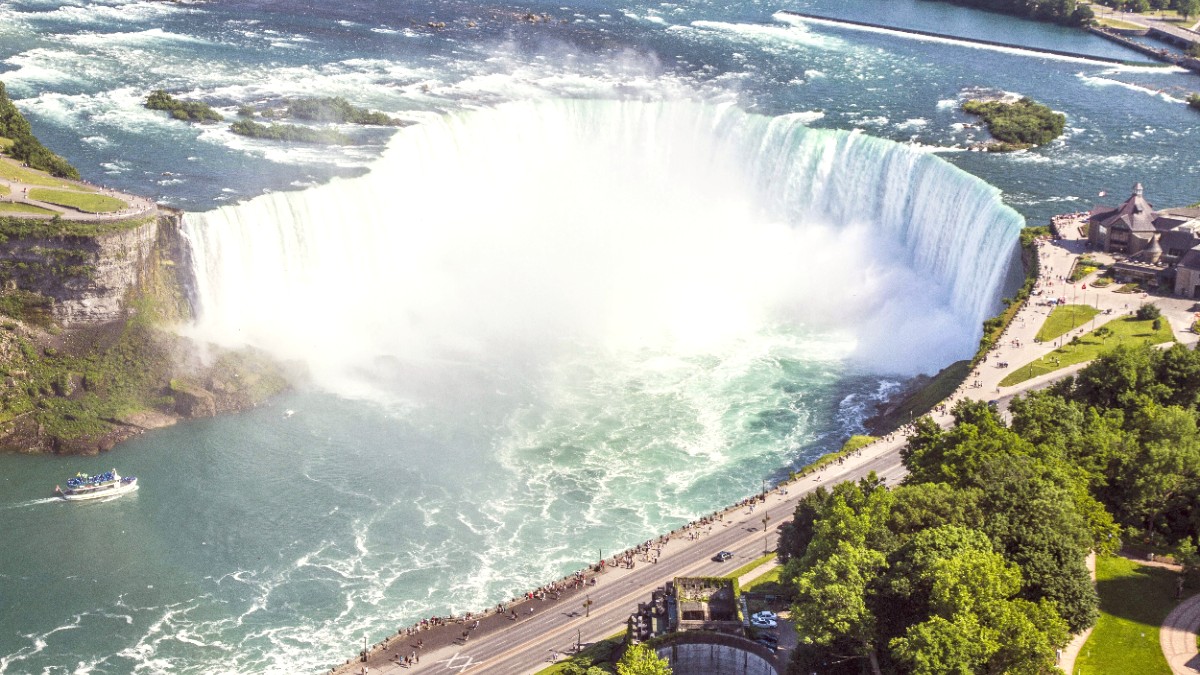
Ontario, Canada
Located in Buffalo, New York, USA, approximately a 45-minute drive from Niagara Falls, Ontario. BUF offers a wider range of direct flights from many U.S. Cities, making it a popular choice for American visitors. Crossing the international border at the Rainbow Bridge becomes necessary when traveling from BUF to the Canadian side of Niagara Falls.
Situated in Toronto, Ontario, Canada, YYZ ranks as Canada's largest and busiest airport. It is approximately a 1.5 to 2-hour drive from Niagara Falls, Ontario. YYZ serves numerous international and domestic routes, presenting connections from virtually anywhere in the world. It provides the most comprehensive flight options for travelers arriving from outside North America.
Approximately a 1-hour drive from Niagara Falls, ON. YHM is a smaller airport serving budget airlines like Swoop and Lynx Air, a cost-effective option for some domestic or limited U.S. Routes.
From Europe, Asia, South America, Africa: Direct flights generally arrive at Toronto Pearson (YYZ). From U.S. Cities: Direct flights to both BUF and YYZ are available, depending on your origin.
All major airports offer comprehensive services, including car rental agencies, currency exchange, duty-free shops, diverse restaurants, and airline lounges.
Main crossings: Rainbow Bridge (closest to Falls), Queenston-Lewiston Bridge (north, less congested), Peace Bridge (south, Fort Erie). A valid passport is necessary. Check real-time border wait times online. Be aware of prohibited items like cannabis.
VIA Rail Canada runs from Toronto Union Station to Niagara Falls (ON). Amtrak connects New York City to Niagara Falls (NY) on the U.S. Side; crossing the Rainbow Bridge on foot or by taxi is necessary to reach the Canadian side.
Megabus connects Niagara Falls (ON) to major Canadian cities like Toronto and Hamilton. Greyhound (USA) connects to Buffalo, NY, for onward travel. Bus travel presents a cost-effective option.
In Canada, driving occurs on the right-hand side of the road. A valid domestic driver's license is necessary; an International Driving Permit (IDP) is advised if your license is not in English or French. Ensure your vehicle insurance policy extends to driving in Canada. Rental cars typically include basic coverage. Gasoline prices are generally comparable to or slightly higher than in the northern U.S., sold by the litre (1 liter is approximately 0.26 US gallons).
Highways in Ontario, including the Queen Elizabeth Way (QEW) leading to Niagara Falls, are generally well-maintained. Winter driving conditions may present challenges from November to March, with snow and ice common. Equip your vehicle with winter tires if traveling during these months. Road safety is generally high. Be aware of speed limits (posted in kilometers per hour) and adhere to them strictly. Use hands-free devices for mobile phones while driving, as distracted driving laws are enforced. Watch for deer, especially on rural roads outside the main city areas.
A car provides flexibility for exploring beyond the main tourist area, like Niagara-on-the-Lake or the Niagara wine region. However, traffic congestion and parking may prove challenging and expensive around the Falls during peak season. Ample paid parking lots exist throughout the Falls area, Clifton Hill, and Niagara Parks. Parking may be costly, especially near popular attractions, and lots fill quickly during peak times. Many hotels offer guest parking, often for an additional fee.
Direct sea or river arrivals are not standard for tourists heading to Niagara Falls, Ontario. The Niagara River is mainly used for recreational boating and commercial shipping (via the Welland Canal), not for passenger transportation to the Falls area itself. The Hornblower Niagara Cruises provides a close-up experience of the Falls from the water, but it is an attraction, not a transportation service for arrival or departure from the region.
Utilize flight deal websites and aggregators to find the best airfares. Flexibility with travel dates and airports often leads to significant savings. Consider flying into Buffalo, NY (BUF) for potential savings if you are comfortable with an international border crossing.
Compare prices from various rental agencies. Book in advance, especially during peak season, to secure better rates and vehicle availability. Be aware of additional costs like parking fees in popular areas.
The WEGO bus system conveniently connects all major attractions, reducing the need for a personal car in the immediate Falls area.
Many of the best views of the Falls are accessible on foot, especially along the Niagara Parkway and Queen Victoria Park.
The Niagara River Recreation Trail offers a scenic and safe option for cycling, stretching for over 50 km.
For land travel between the U.S. And Canada, choose your border crossing carefully. The Rainbow Bridge offers proximity to the Falls, but often features longer wait times. The Queenston-Lewiston Bridge typically experiences less congestion. Always have your passport ready and be prepared for customs questions.
Upon arrival at Toronto Pearson (YYZ) or Buffalo Niagara (BUF), numerous transfer options connect you to Niagara Falls. Pre-booking shuttles or reviewing train/bus schedules streamlines your journey. Keep local taxi and rideshare app information handy for on-demand transport.
Arrive 2-3 hours before international flights and 1.5-2 hours before domestic flights to allow for check-in and security.
If driving to the U.S., check border wait times before leaving Niagara Falls, especially on weekends or holidays.
For train or bus departures, arrive 30-60 minutes early for smooth boarding and ticket validation.
Canada has no departure tax for individuals leaving the country. Airport improvement fees are usually included in your airline ticket price.